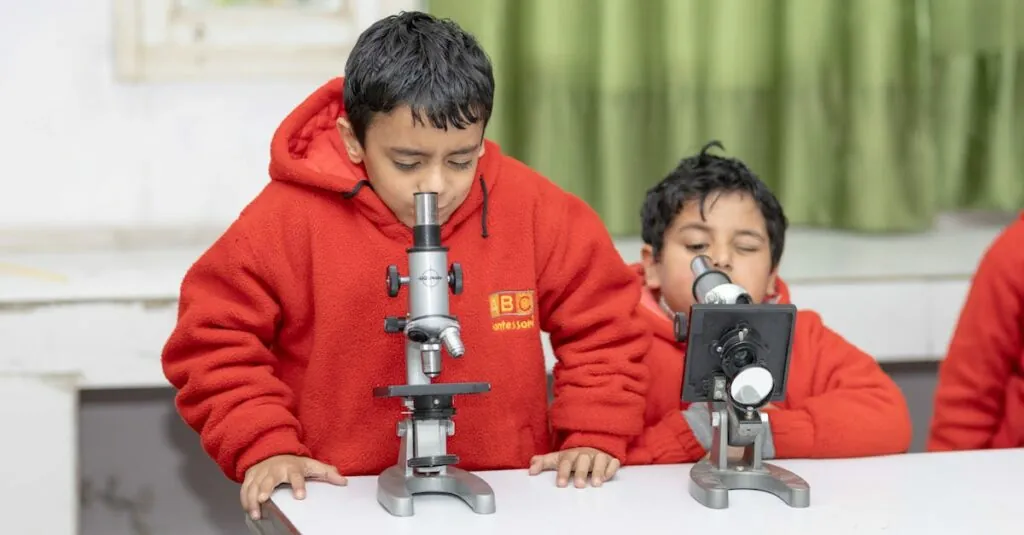Table of Contents
ToggleSTEM for kids is like the secret sauce that transforms ordinary learning into an exciting adventure. Imagine a world where science, technology, engineering, and math come together to spark curiosity and creativity in young minds. It’s not just about crunching numbers or memorizing formulas; it’s about building rockets from household items and coding games that even the family cat would want to play.
Understanding STEM Education
STEM education encompasses crucial areas such as science, technology, engineering, and math. This approach fosters creative thinking and problem-solving skills through interactive learning experiences.
Definition of STEM
STEM stands for science, technology, engineering, and math. Each component plays a vital role in understanding the world. Science involves experimentation and observation. Technology introduces tools for innovation. Engineering applies scientific principles to design solutions. Math provides a framework for understanding patterns and quantitative reasoning. Together, these fields create a comprehensive framework for students, allowing them to explore concepts in a hands-on manner.
Importance of STEM for Kids
STEM education equips kids with essential skills for the future. Critical thinking develops through problem-solving activities. Collaboration fosters teamwork during group projects. Engaging with real-world challenges builds resilience and adaptability. According to the U.S. Bureau of Labor Statistics, jobs in STEM fields are projected to grow by 10.5 million from 2020 to 2030. Emphasizing STEM early prepares children for a competitive job market, ensuring they possess the necessary competencies for success.
The Components of STEM
STEM consists of four essential components that contribute to a well-rounded education for children. Each element uniquely enhances learning experiences and prepares kids for future challenges.
Science
Science encourages curiosity through experimentation and observation. Kids engage with the world, asking questions and testing hypotheses. This hands-on approach fosters critical thinking skills as they explore concepts like biology, physics, and chemistry. For instance, creating a simple volcano experiment introduces basic chemical reactions, captivating young minds. Experiences in science boost children’s confidence, encouraging them to think creatively and solve problems.
Technology
Technology plays a vital role in modern education, providing tools that enhance learning. Using computers, tablets, and coding software allows children to interact with digital content. With platforms for learning programming languages, they develop essential skills for the future job market. Building applications or designing websites can ignite their creativity, motivating them to pursue technological innovations. Exploration of technology helps kids adapt to the rapidly changing digital landscape.
Engineering
Engineering applies scientific principles, fostering problem-solving and design skills. Projects like building bridges or designing structures challenge children to think critically about materials and design criteria. Working collaboratively on engineering projects enhances teamwork abilities, as they share ideas and develop solutions together. This hands-on approach inspires kids to pursue engineering fields by igniting their passion for creating practical solutions to everyday challenges.
Mathematics
Mathematics provides a foundation for understanding patterns and relationships. Engaging children with math through interactive games makes learning enjoyable. Concepts like addition, subtraction, geometry, and statistics enable kids to solve real-world problems. Real-life applications, such as budgeting for a school project, illustrate the practical importance of math. Mastery of mathematical concepts cultivates logical reasoning and analytical skills necessary for success in various STEM fields.
Benefits of STEM Learning for Kids
STEM learning fosters essential developmental skills in children. It equips them to navigate a rapidly evolving world through focused educational approaches.
Critical Thinking Skills
Critical thinking becomes a focal point in STEM education. Through experiments and problem-solving tasks, kids learn to analyze situations logically. They develop techniques for evaluating solutions and understanding outcomes. Engaging in STEM activities encourages them to ask questions and explore various perspectives. For instance, constructing a simple circuit teaches children to troubleshoot and hypothesize about functionality. This continuous process of inquiry shapes a mindset geared towards critical evaluation, which can benefit them in many life scenarios.
Creativity and Innovation
Creativity flourishes in STEM contexts where exploration is encouraged. Students engage in projects that require them to brainstorm and innovate. They create unique solutions to problems, enhancing their imaginative capabilities. A project involving robotics or coding illustrates how they can turn abstract ideas into functional designs. Such experiences allow kids to experiment and learn from their mistakes, nurturing resilience. This emphasis on creativity enables them to approach challenges with fresh ideas and unique solutions that can set them apart.
Career Readiness
STEM education plays a crucial role in preparing kids for future careers. Exposure to science, technology, engineering, and math opens doors in rapidly growing job markets. Skills gained through STEM learning lay a foundation for success in fields like engineering, computer science, and healthcare. Engaging in collaborative projects mirrors real-world work environments, fostering teamwork and communication. As they participate in STEM-related activities, kids gain confidence and fluency in applying their knowledge, making them attractive candidates for a variety of careers.
STEM Activities for Kids
STEM activities engage children through interactive learning experiences, making education both fun and effective. Various types of hands-on experiments, educational games, and online resources provide valuable opportunities for learning.
Hands-On Experiments
Hands-on experiments capture children’s curiosity and foster critical thinking. Projects like building a simple volcano illustrate chemical reactions effectively. Kids can also create homemade slime to explore polymers or construct a water rocket to demonstrate physics principles. Engaging in these activities facilitates learning as children make observations and draw conclusions based on their experiences.
Educational Games
Educational games make learning exciting while reinforcing STEM concepts. Games such as math puzzles or coding challenges enhance problem-solving skills. Interactive board games can teach engineering principles while promoting teamwork among players. These enjoyable activities not only entertain but also encourage logical reasoning and strategic thinking.
Online Resources
Online resources provide access to a wealth of STEM learning tools. Websites like Khan Academy and Code.org offer interactive courses tailored to various age groups. Many platforms host videos and tutorials that guide kids through appealing STEM projects at home. Interactive apps also engage children while allowing them to practice their skills in science, technology, engineering, and mathematics.
STEM education for kids is more than just a curriculum; it’s a gateway to a world of creativity and innovation. By engaging in hands-on activities and interactive learning, children develop essential skills that prepare them for future challenges. As they explore science technology engineering and math, they cultivate critical thinking problem-solving and collaboration skills that are vital in today’s job market.
Emphasizing fun and exploration makes STEM learning enjoyable and effective. With numerous resources and activities available, parents and educators can inspire the next generation of thinkers and creators. Investing in STEM education today ensures that children are equipped with the tools they need to thrive tomorrow.








